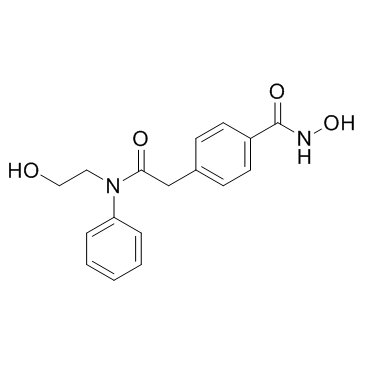
HPOB
CAS No. 1429651-50-2
HPOB( —— )
Catalog No. M11815 CAS No. 1429651-50-2
A potent and selective HDAC6 inhibitor (IC50=56 nM).
Purity : >98% (HPLC)
 COA
COA
 Datasheet
Datasheet
 HNMR
HNMR
 HPLC
HPLC
 MSDS
MSDS
 Handing Instructions
Handing Instructions
| Size | Price / USD | Stock | Quantity |
| 5MG | 45 | Get Quote |


|
| 10MG | 65 | Get Quote |


|
| 100MG | Get Quote | Get Quote |


|
| 200MG | Get Quote | Get Quote |


|
| 500MG | Get Quote | Get Quote |


|
| 1G | Get Quote | Get Quote |


|
Biological Information
-
Product NameHPOB
-
NoteResearch use only, not for human use.
-
Brief DescriptionA potent and selective HDAC6 inhibitor (IC50=56 nM).
-
DescriptionA potent and selective HDAC6 inhibitor (IC50=56 nM); shows IC50>1.7 uM for the other HDACs, more potent than tubacin; selectively inhibits HDAC6 catalytic activity in vivo and in vitro; causes growth inhibition of normal and transformed cells but does not induce cell death; enhances the effectiveness of DNA-damaging anticancer drugs in transformed cells but not normal cells.
-
In VitroHPOB (8, 16, or 32 μM; 72 hours) inhibits growth, however, not viability, of normal or transformed cells.In normal (HFS) and transformed (LNCAP, U87, and A549) cells, HPOB causes accumulation of acetylated α-tubulin and acetylated peroxiredoxin, substrates of HDAC6, but not of acetylated histones. HPOB enhances etoposide-, doxorubicin-, and SAHA-induced transformed cell ((LNCAP, U87, and A549 cells) death but not normal cell death. In LNCaP cells cultured with HPOB and etoposide, there was an increase in cleaved PARP, a marker of apoptosis. Combination of HPOB with etoposide increased the accumulation of DNA damage compared with etoposide alone as evidenced by accumulation of γH2AX in LNCaP cells.HPOB attenuates corticosterone-induced injury in rat adrenal pheochromocytoma PC12 cells by inhibiting mitochondrial GR translocation and the intrinsic apoptosis pathway.Cell Proliferation Assay Cell Line:Normal human foreskin fibroblast (HFS), LNCaP, A549, U87 cellsConcentration:8, 16, or 32 μM Incubation Time:72 hours Result:Inhibited cell growth of normal and transformed cells in a concentration-dependent mannerbut do not induce cell death of normal or transformed cells.
-
In VivoHPOB (300 mg/kg; i.p.; daily for 18 days) and SAHA (50 mg/kg) causes suppression of the growth of established CWR22 tumors. Animal Model:Nude mice (CWR22 human prostate cancer xenograf)Dosage:300 mg/kg Administration:I.p.; daily for 18 days Result:Combination with SAHA showed significant shrinkage of CWR22 tumors.
-
Synonyms——
-
PathwayCell Cycle/DNA Damage
-
TargetHDAC
-
RecptorHDAC1|HDAC10|HDAC3|HDAC6|HDAC8
-
Research AreaCancer
-
Indication——
Chemical Information
-
CAS Number1429651-50-2
-
Formula Weight314.3358
-
Molecular FormulaC17H18N2O4
-
Purity>98% (HPLC)
-
Solubility10 mM in DMSO
-
SMILESC1=CC=C(C=C1)N(CCO)C(=O)CC2=CC=C(C=C2)C(=O)NO
-
Chemical NameBenzeneacetamide, 4-[(hydroxyamino)carbonyl]-N-(2-hydroxyethyl)-N-phenyl-
Shipping & Storage Information
-
Storage(-20℃)
-
ShippingWith Ice Pack
-
Stability≥ 2 years
Reference
1. Lee JH, et al. Proc Natl Acad Sci U S A. 2013 Sep 24;110(39):15704-9.
2. Li ZY, et al. Neurochem Int. 2016 Oct;99:239-51.
molnova catalog



related products
-
(2R/S)-6-PNG
(2R/S)-6-PNG (6-Prenylnaringenin) is a novel natural histone deacetylase inhibitor with anticancer and antitumor activity, and it blocks T-type calcium channels to reduce neuropathic and visceral pain in mice.
-
MC2590
MC2590 is a potent and selective histone deacetylase (HDAC) inhibitor that inhibits HDAC1-3, -6, -8, and -10 activities, induces cell cycle arrest, and promotes apoptosis.
-
Trichostatin A (TSA)
Trichostatin A (TSA) is an HDAC inhibitor with IC50 of ~1.8 nM – HDAC8 is the only known member of the HDAC-family that is not affected by TSA.



 Cart
Cart
 sales@molnova.com
sales@molnova.com


